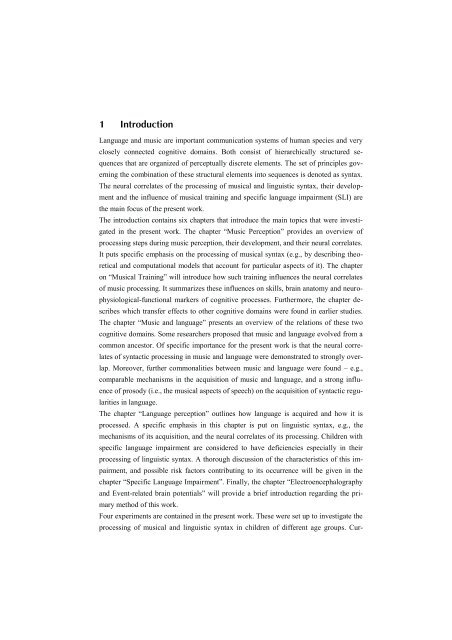Neural Correlates of Processing Syntax in Music and ... - PubMan
Neural Correlates of Processing Syntax in Music and ... - PubMan
Neural Correlates of Processing Syntax in Music and ... - PubMan
You also want an ePaper? Increase the reach of your titles
YUMPU automatically turns print PDFs into web optimized ePapers that Google loves.
1 Introduction<br />
Language <strong>and</strong> music are important communication systems <strong>of</strong> human species <strong>and</strong> very<br />
closely connected cognitive doma<strong>in</strong>s. Both consist <strong>of</strong> hierarchically structured sequences<br />
that are organized <strong>of</strong> perceptually discrete elements. The set <strong>of</strong> pr<strong>in</strong>ciples govern<strong>in</strong>g<br />
the comb<strong>in</strong>ation <strong>of</strong> these structural elements <strong>in</strong>to sequences is denoted as syntax.<br />
The neural correlates <strong>of</strong> the process<strong>in</strong>g <strong>of</strong> musical <strong>and</strong> l<strong>in</strong>guistic syntax, their development<br />
<strong>and</strong> the <strong>in</strong>fluence <strong>of</strong> musical tra<strong>in</strong><strong>in</strong>g <strong>and</strong> specific language impairment (SLI) are<br />
the ma<strong>in</strong> focus <strong>of</strong> the present work.<br />
The <strong>in</strong>troduction conta<strong>in</strong>s six chapters that <strong>in</strong>troduce the ma<strong>in</strong> topics that were <strong>in</strong>vestigated<br />
<strong>in</strong> the present work. The chapter “<strong>Music</strong> Perception” provides an overview <strong>of</strong><br />
process<strong>in</strong>g steps dur<strong>in</strong>g music perception, their development, <strong>and</strong> their neural correlates.<br />
It puts specific emphasis on the process<strong>in</strong>g <strong>of</strong> musical syntax (e.g., by describ<strong>in</strong>g theoretical<br />
<strong>and</strong> computational models that account for particular aspects <strong>of</strong> it). The chapter<br />
on “<strong>Music</strong>al Tra<strong>in</strong><strong>in</strong>g” will <strong>in</strong>troduce how such tra<strong>in</strong><strong>in</strong>g <strong>in</strong>fluences the neural correlates<br />
<strong>of</strong> music process<strong>in</strong>g. It summarizes these <strong>in</strong>fluences on skills, bra<strong>in</strong> anatomy <strong>and</strong> neurophysiological-functional<br />
markers <strong>of</strong> cognitive processes. Furthermore, the chapter describes<br />
which transfer effects to other cognitive doma<strong>in</strong>s were found <strong>in</strong> earlier studies.<br />
The chapter “<strong>Music</strong> <strong>and</strong> language” presents an overview <strong>of</strong> the relations <strong>of</strong> these two<br />
cognitive doma<strong>in</strong>s. Some researchers proposed that music <strong>and</strong> language evolved from a<br />
common ancestor. Of specific importance for the present work is that the neural correlates<br />
<strong>of</strong> syntactic process<strong>in</strong>g <strong>in</strong> music <strong>and</strong> language were demonstrated to strongly overlap.<br />
Moreover, further commonalities between music <strong>and</strong> language were found – e.g.,<br />
comparable mechanisms <strong>in</strong> the acquisition <strong>of</strong> music <strong>and</strong> language, <strong>and</strong> a strong <strong>in</strong>fluence<br />
<strong>of</strong> prosody (i.e., the musical aspects <strong>of</strong> speech) on the acquisition <strong>of</strong> syntactic regularities<br />
<strong>in</strong> language.<br />
The chapter “Language perception” outl<strong>in</strong>es how language is acquired <strong>and</strong> how it is<br />
processed. A specific emphasis <strong>in</strong> this chapter is put on l<strong>in</strong>guistic syntax, e.g., the<br />
mechanisms <strong>of</strong> its acquisition, <strong>and</strong> the neural correlates <strong>of</strong> its process<strong>in</strong>g. Children with<br />
specific language impairment are considered to have deficiencies especially <strong>in</strong> their<br />
process<strong>in</strong>g <strong>of</strong> l<strong>in</strong>guistic syntax. A thorough discussion <strong>of</strong> the characteristics <strong>of</strong> this impairment,<br />
<strong>and</strong> possible risk factors contribut<strong>in</strong>g to its occurrence will be given <strong>in</strong> the<br />
chapter “Specific Language Impairment”. F<strong>in</strong>ally, the chapter “Electroencephalography<br />
<strong>and</strong> Event-related bra<strong>in</strong> potentials” will provide a brief <strong>in</strong>troduction regard<strong>in</strong>g the primary<br />
method <strong>of</strong> this work.<br />
Four experiments are conta<strong>in</strong>ed <strong>in</strong> the present work. These were set up to <strong>in</strong>vestigate the<br />
process<strong>in</strong>g <strong>of</strong> musical <strong>and</strong> l<strong>in</strong>guistic syntax <strong>in</strong> children <strong>of</strong> different age groups. Cur-












